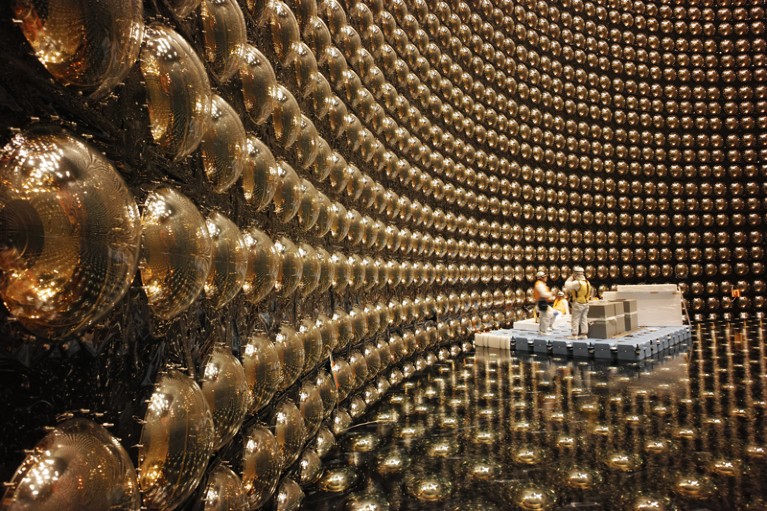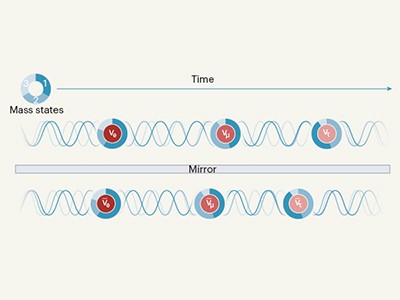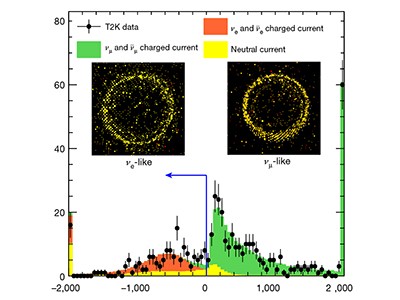
Inside the Super-Kamiokande neutrino detector during work on the detectors.Credit: Kamioka Observatory, ICRR, Univ. Tokyo
Nuclear-weapons physicists Clyde Cowan and Frederick Reines considered the neutrino “the smallest bit of material reality ever conceived of by man” [sic].
That was in a commentary1 for Nature in 1956, published a few months after they published a paper in Science2 reporting the experimental discovery of neutrinos. These subatomic particles lack an electrical charge and are extremely hard to detect, because they have very little interaction with other forms of matter. The pair wondered about the relationship between neutrinos and their counterparts, antineutrinos. With the benefit of hindsight, that turned out to be a rather important question.
In this week’s Nature, researchers — directly following in the footsteps of Cowan and Reines — suggest that differences between neutrinos and antineutrinos might help to explain one of the Universe’s biggest mysteries3.
Some 13.8 billion years ago, at the time of the Big Bang, every particle of matter in the early Universe should have been created together with a counterpart called antimatter. Antimatter is precisely the same as matter but with some opposite physical property, such as electrical charge. That, at least, is what current theories propose.
The great mystery for physicists is why there seems to be so much more matter than antimatter in the current Universe. This, however, is just as well — if there had been equal quantities of both, each particle would have cancelled each other out in a blaze of energy, leaving the Universe full of just photons and dark matter.
Ten years after Cowan and Reines discovered the neutrino, the Russian physicist and human-rights campaigner Andrei Sakharov proposed a mechanism for how the balance — or symmetry — between matter and antimatter might have come to be violated. One of Sakharov’s suggested reasons was that their symmetry was not perfect, and that each exhibited slightly different properties. This difference might have led to a surplus of matter during the cooling that took place soon after the Big Bang.
But was Sakharov right? A particle-physics experiment called Tokai to Kamioka, or T2K, run by an international collaboration of hundreds of physicists, is now offering a hint that he might have been.
Matter–antimatter symmetry violated
In the T2K experiment, neutrinos are generated at the Japan Proton Accelerator Research Complex (J-PARC) at Tokai, on Japan’s east coast. From there, they are fired underground and travel 295 kilometres towards a neutrino observatory called Super‑Kamiokande on the west coast. The centrepiece of the observatory is a giant water tank lined with thousands of detectors ready to capture the light emitted as neutrinos interact with the water. Because neutrinos have an extremely small chance of interaction, these kinds of experiment take years to gather enough data for scientists to draw meaningful conclusions. It took T2K a decade to detect just 90 neutrinos and 15 antineutrinos — from around 1020 potential neutrino-generating collisions at J-PARC.
Using these data, the T2K collaboration measured the probability that a neutrino would oscillate between different physical properties that physicists call ‘flavours’ during its journey. The team then ran the same experiment with antineutrinos, and compared the numbers. If matter and antimatter are perfectly symmetrical, the probabilities should be the same.
The results, however, suggest they are not. T2K detected a higher probability that neutrinos would change flavour during their 300-km journey — and a correspondingly lower probability for antineutrinos — than would be expected if they behaved identically.
Trust but verify
Such a finding, if it can be confirmed, lends weight to Sakharov’s explanation from 1967 that matter and antimatter have different properties4. But there’s a caveat: the current finding does not satisfy the required level of confidence — known as 5-sigma (5σ) — that particle physicists would typically demand to consider the result a discovery. The present T2K results are at a 3σ level of statistical significance — and this drops to 2σ if matter–antimatter symmetry is to be ruled out entirely.
Even so, it’s important to publish such fundamental work as it progresses. Experiments in particle physics can take decades to be planned and built, so results that are not yet at the 5σ significance have a crucial role in informing the community’s decisions on future investments.
The researchers could have waited longer. But even if they had, the T2K experiment is unlikely to have provided the additional data required to cross the 5σ finishing line. To get to 5σ, physicists will need results from the next generation of neutrino detectors. Fortunately, there are three such detectors due to come on stream: Hyper-Kamiokande, located near Super-Kamiokande, expected to start in 2027; DUNE in the United States, due to start in 2025; and JUNO in China, which aims to be the first of the three to go live, in 2022.
Time will tell if these preliminary observations hold. But at a time when big investments in high-energy physics are coming under increased scrutiny, this result reinforces the importance of continuing to search for answers to some of the Universe’s deepest mysteries.


 Read the paper: Constraint on the matter–antimatter symmetry-violating phase in neutrino oscillations
Read the paper: Constraint on the matter–antimatter symmetry-violating phase in neutrino oscillations
 Matter–antimatter symmetry violated
Matter–antimatter symmetry violated
 Nature Video: Inside Japan’s big physics
Nature Video: Inside Japan’s big physics
 Nature Physics Focus: European Strategy for Particle Physics
Nature Physics Focus: European Strategy for Particle Physics
 Japan will build the world’s largest neutrino detector
Japan will build the world’s largest neutrino detector








